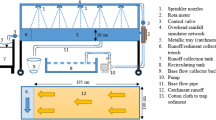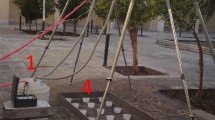Abstract
Predictions of soil and water loss at large extents often relies on data obtained from laboratory flume experiments. It is necessary to have a reliable approach to extrapolate from laboratory collected data to larger field areas. In this study, a series of experiments were designed using rainfall simulator on laboratory flumes with varying surface areas (ranging from 0.5 to 2.5 m2) as well as field plots ranging in surface areas between 4 and 20 m2. Both the flumes and field plots had the same slope gradient (20°), surface trait (bare slope) and soil type (red soil). We varied rainfall intensities from 30 to 150 mm/h, and measured runoff and erosion. Results confirmed that actual erosion in field cannot be simply extrapolated from laboratory data, rather we showed that erosion modulus directly relates to surface area and rainfall intensity in both the laboratory and field experiments. However, the effect of surface area on runoff is more complicated. Compared to surface area, rainfall intensity showed more pronounced influence on runoff. Based on our experimental results, a conversion calculation method was investigated and a conversion coefficient model, which is a function of rainfall intensity and ratio of field area to laboratory area, was introduced. The model provides a reference for laboratory to field conversions and allows for soil erosion prediction at larger extents in the field.






Similar content being viewed by others
REFERENCES
Alves Sobrinho, T., Gomez-Macpherson, H., and Gomez, J.A., A portable integrated rainfall and overland flow simulator, Soil Use Manage., 2008, vol. 24, pp. 163‒170.
Abrahams, A.D., Parsons. A.J., and Luk, S.H., The effect of spatial variability in overland flow on the downslope pattern of soil loss on a semiarid hill slope, southern Arizona, Catena, 1991, vol. 18, pp. 255‒270.
Bryan, R.B. and Poesen, J., Laboratory experiments on the influence of slope length on runoff, percolation and rill development, Earth Surf. Processes Landforms, 1989, vol. 14, pp. 211‒231.
Boyce, R.C., Sediment routing with sediment-delivery ratios, in Present and Prospective Technology for Predicting Sediment Yields and Sources: Proceedings of the Sediment-Yield Workshop, USDA Sedimentation Laboratory, Oxford, US Department of Agriculture, 1975, pp. 61‒65.
Bochet, E., Rubio, J.L., and Poesen, J., Modified topsoil islands within patchy Mediterranean vegetation in SE Spain, Catena, 1999, vol. 38, pp. 23‒44.
Cerdà, A. and Jurgensen, M.F., Ant mounds as a source of sediment on citrus orchard plantations in eastern Spain. A three-scale rainfall simulation approach, Catena, 2011, vol. 85, pp. 231‒236.
Cerdan, O., Le Bissonnais, Y., Couturier, A., and Saby, N., Modeling interrill erosion in small cultivated catchments, Hydrol. Processes, 2002, vol. 16, pp. 3215‒3226.
Cerdan, O., Le Bissonnais, Y., Govers, G., Lecomte, V., Van Oost, K., Couturier, A., King, C., and Dubreuil, N., Scale effect on runoff from experimental plots to catchments in agricultural areas in Normandy, J. Hydrol., 2004, vol. 299, pp. 4‒14.
Cammeraat, L.H., A review of two strongly contrasting geomorphological systems within the context of scale, Earth Surf. Processes Landforms, 2002, vol. 27, pp. 1201‒1222.
Chaplot, V. and Bissonnais, Y.L., Field measurements of interrill erosion under different slopes and plot sizes, Earth Surf. Processes Landforms, 2000, vol. 25, pp. 145‒153.
De Vente, J. and Poesen, J., Predicting soil erosion and sediment yield at the basin scale: scale issues and semi-quantitative models, Earth-Sci. Rev., 2005, vol. 71, pp. 95‒125.
Duusings, J.J.H.M., A sediment budget for a forested catchment in Luxembourg and its implications for channel development, Earth Surf. Processes Landforms, 1987, vol. 12, pp. 173‒184.
Duley, F.L. and Ackerman, F.G., Run-off and erosion from plots of different lengths, J. Agric. Res., 1934, vol. 48, pp. 505‒510.
Dunne, T., Zhang, W.X., and Aubry, B.F., Effects of rainfall, vegetation, and microtopography on infiltration and runoff, Water Resour. Res., 1991, vol. 27, pp. 2271‒2285.
Gilley, J.E., Woolhiser, D.A., and McWhorter, D.B., Interrill soil erosion. Part II: Testing and use of model equations, Trans. Am. Soc. Agric. Eng., 1985, vol. 28, pp. 154‒159.
Joel, A., Messing, I., Seguel, O., and Casanova, M., Measurement of surface water runoff from plots of two different sizes, Hydrol. Processes, 2002, vol. 16, pp. 1467‒1478.
Julien, P.Y. and Moglen, G.E., Similarity and length scale for spatial varied overland flow, Water Resour. Res., 1990, vol. 26, pp. 1819‒1832.
Le Bissonnais, Y., Benkhadra, H., Chaplot, V., Fox, D., King, D., and Daroussin, J., Crusting, runoff and sheet erosion on silty loamy soils at various scales and upscaling from m2 to small catchments, Soil Tillage Res., 1998, vol. 46, pp. 69‒80.
Lal, R., Soil Erosion Research Methods (Second edition), Soil and water conservation society and St. Lucie Press, 1994, p. 12.
Moreno-de las Heras, M., Nicolau, J.M., Merino-Martín, Luis., and Wilcox, B.P., Plot-scale effects on runoff and erosion along a slope degradation gradient, Water Resour. Res., 2010, vol. 46, p. W04503.
Mueller, E.N., Wainwright, J., and Parsons, A.J., Impact of connectivity on the modeling of overland flow within semiarid shrubland environments, Water Resour. Res., 2007, vol.43, p. W09412.
Mutchler, C.K. and Greer, J.D., Effect of slope length on erosion from low slopes, Trans. ASAE., 1980, vol. 23, pp. 0866‒0869.
Nicolau, J.M., Runoff generation and routing on artificial slopes in a Mediterranean-continental environment: the Teruel coalfield Spain, Hydrol. Processes, 2002, vol. 16, pp. 631‒647.
Nadal-Romero, E., Regues, D., and Latron, J., Relationships among rainfall, runoff, and suspended sediment in a small catchment with badlands, Catena, 2008, vol. 74, pp. 127‒136.
Neff, E.L., Why rainfall simulation? In Proceedings of rainfall simulator workshop, Tucson, Az. USDA-SEA ARM-W-10, 1979, pp. 3‒7.
Parsons, A.J., Brazier, R.E., Wainwright, J., and Powell, D.M., Scale relationships in hillslope runoff and erosion, Earth Surf. Processes Landforms, 2006, vol. 31, pp. 1384‒1393.
Parsons, A.J., Wainwright, J., Mark Powell, D., Kaduk, J., and Brazier, R.E., A conceptual model for determining soil erosion by water, Earth Surf. Processes Landforms, 2004, vol. 29, pp. 1293‒1302.
Robinson, A.R., Relationship between soil erosion and sediment delivery, IAHS Publ., 1977, vol. 122, pp. 159‒167.
Sensoy, H. and Kara, O., Slope shape effect on runoff and soil erosion under natural rainfall conditions, Forest-Biogeosci. Forestry, 2014, vol. 7, pp. 110‒114.
Stomph, T.J., de Ridder, N., Steenhuis, T.S., and Van de Giesen, N.C., Scale effects of Hortonian overland flow and rainfall-runoff dynamics: Laboratory validation of process-based model, Earth Surf. Processes Landforms, 2002, vol. 27, pp. 847‒855.
Sidle, R.C., Hirano, T., Gomi, T., and Terajima, T., Hortonian overland flow from Japanese forest plantations-an aberration, the real thing, or something in between?, Hydrol. Processes, 2007, vol. 21, pp. 3237‒3247.
Van de Giesen, N.C., Stomph, T.J., and de Ridder, N., Scale effects of Hortonian overland and rainfall-runoff dynamics in a West African catena landscape, Hydrol. Processes, 2000, vol. 14, pp. 165‒175.
Van de Giesen, N.C., Stomph, T.J., and de Ridder, N., Surface runoff scale effects in West African watersheds: modeling and management options, Agric. Water Manage., 2005, vol. 72, pp. 109‒130.
Van de Giesen, N.C., Stomph, T.J., Ajayi, A.E., Bagayoko, F., Scale effects in Hortonian surface runoff on agricultural slopes in West Africa: field data and models, Agric., Ecosyst. Environ., 2011, vol. 142, pp. 95‒101.
Vigiak, O., van Dijck, S.J.E., van Loon, E.E., Stroosnijer, L., Matching hydrologic response to measured effective hydraulic conductivity, Hydrol. Processes, 2006, vol. 20, pp. 487‒504.
Valentin, C. and Poesen, J., The significance of soil, water and landscape processes in banded vegetation patterning, Catena, 1999, vol. 37, pp. 197‒216.
Walling, D.E., The sediment delivery problem, J. Hydrol., 1983, vol. 65, pp. 209‒237.
Wischmeier, W.H., Smith, D.D., Predicting rainfall erosion losses. Agricultural Handbook 537. USDA, Washington, DC: Science and Education Administration, 1978.
Wainwright, J. and Parsons, A.J., The effect of temporal variations in rainfall on scale dependency in runoff coefficients, Water Resour. Res., 2002, vol. 38, pp. 7‒1‒7‒10.
Wilcox, B.P., Breshears, D.D., and Allen, C.D., Ecohydrology of a resource-conserving semiarid woodland: effects of scale and disturbance, Ecol. Monogr., 2003, vol. 73, pp. 223‒239.
Yair, A. and Raz-Yassif, N., Hydrological processes in a small arid catchment: scale effects of rainfall and slope length, Geomorphology, 2004, vol. 61, pp. 155‒169.
Zhang, X.C., Nearing, M.A., Risse, L.M., and McGregor, K.C., Evaluation of WEPP runoff and soil loss predictions using natural runoff plot data, Trans. Am. Soc. Agric. Eng., 1996, vol. 39, pp. 855‒863.
ACKNOWLEDGMENTS
The study was funded by National Natural Science Foundation of China (51 309 173) and Shanxi water conservancy science and technology research and promotion project (201 820). The authors would like to acknowledge the support from the soil and water conservation experimental station of Anji County and show appreciation to the people who participated in the experiments.
Author information
Authors and Affiliations
Corresponding authors
Rights and permissions
About this article
Cite this article
Fu, X.T., Zhang, L.P. & Wang, Y. Effect of Slope Length and Rainfall Intensity on Runoff and Erosion Conversion from Laboratory to Field. Water Resour 46, 530–541 (2019). https://doi.org/10.1134/S0097807819040080
Received:
Revised:
Accepted:
Published:
Issue Date:
DOI: https://doi.org/10.1134/S0097807819040080




